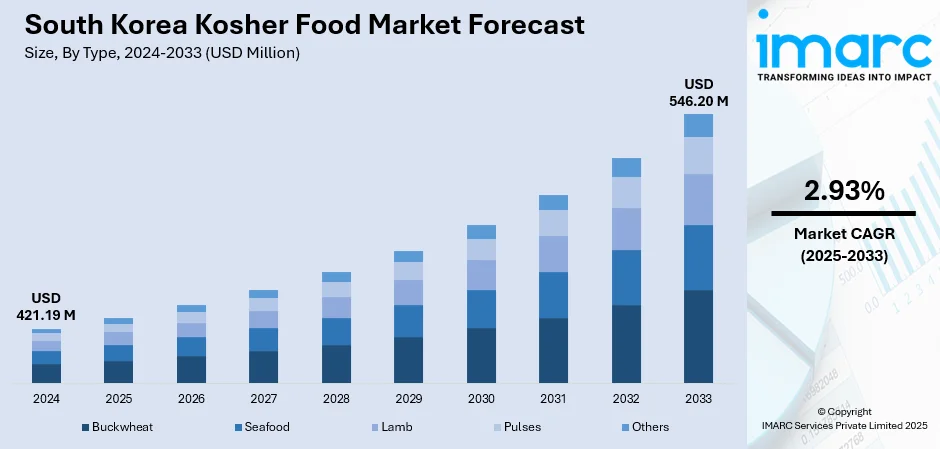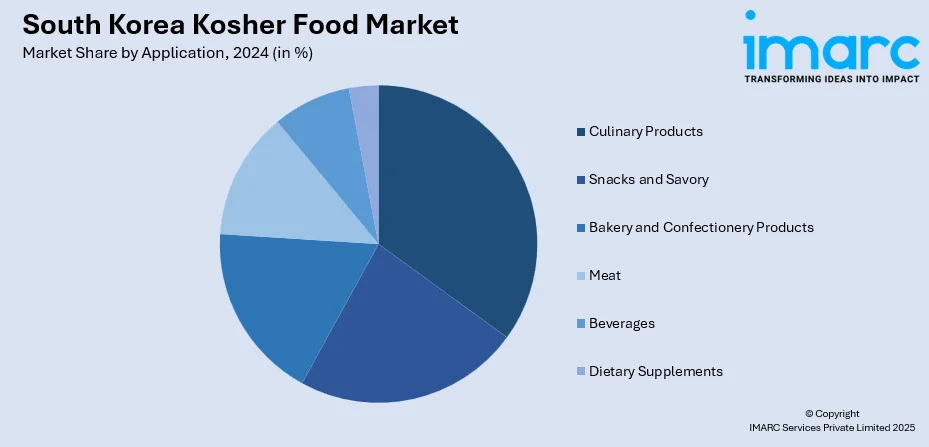
South Korea Kosher Food Market Size, Share, Trends and Forecast by Type, Application, Distribution Channel, and Region, 2025-2033
South Korea Kosher Food Market Overview:
The South Korea kosher food market size reached USD 421.19 Million in 2024. Looking forward, the market is expected to reach USD 546.20 Million by 2033, exhibiting a growth rate (CAGR) of 2.93% during 2025-2033. The market is expanding due to rising consumer awareness, health-focused dietary preferences, and increased exports to kosher-observant countries. Local producers are adopting kosher standards to meet global demand. Regulatory support and improved certification access are also contributing to market development. These factors are steadily increasing the South Korea kosher food market share.
|
Report Attribute
|
Key Statistics
|
|---|---|
|
Base Year
|
2024
|
|
Forecast Years
|
2025-2033
|
|
Historical Years
|
2019-2024
|
| Market Size in 2024 | USD 421.19 Million |
| Market Forecast in 2033 | USD 546.20 Million |
| Market Growth Rate 2025-2033 | 2.93% |
South Korea Kosher Food Market Trends:
Rising Health and Wellness Awareness
South Korean consumers are increasingly prioritizing health, transparency, and clean-label foods. Kosher-certified products are perceived as higher in quality and safety due to strict preparation and processing standards. This aligns with the growing demand for additive-free, allergen-conscious, and ethically produced food. Kosher foods often overlap with vegan, organic, and gluten-free labels, further enhancing their appeal to health-focused buyers. The shift toward mindful eating, driven by concerns over food origins, ingredient integrity, and sustainable practices, is leading both mainstream and niche consumer groups to explore kosher-certified options. As wellness culture continues to influence shopping behavior, kosher food is becoming a preferred choice not only among religious communities but also among health-conscious South Korean consumers.

To get more information on this market, Request Sample
Increased Availability of Kosher Certification Services
Previously, limited access to kosher certification agencies posed a barrier for South Korean businesses. However, the growing presence of international kosher certifiers, including partnerships with local organizations, has made certification more attainable and cost-effective. As a result, more manufacturers, especially SMEs, can now pursue kosher labeling without extensive logistical or financial challenges. This improved accessibility has encouraged domestic food and beverage companies to adapt production processes to meet kosher standards. Additionally, educational initiatives and trade seminars have raised industry awareness about the benefits of kosher certification, including enhanced export potential and expanded domestic appeal. With the certification process becoming more streamlined, the number of kosher-certified products on the South Korean market is steadily increasing, driving overall South Korea kosher food market growth.
Growth in International Trade and Exports
South Korean food manufacturers are increasingly targeting overseas markets, especially in North America and Israel, where kosher certification is essential. As demand rises in these export regions, local producers are investing in obtaining kosher certification to enhance marketability and credibility. Kosher certification allows South Korean companies to differentiate their products globally, access new distribution channels, and comply with international food regulations. This is particularly relevant for processed foods, seafood, snacks, and beverages, key export categories for Korea. Government-backed trade promotion programs and free trade agreements have further incentivized companies to meet international certification standards, including kosher. The need to remain competitive in global markets is a powerful motivator for expanding kosher-compliant production across South Korea.
South Korea Kosher Food Market Segmentation:
IMARC Group provides an analysis of the key trends in each segment of the market, along with forecasts at the country and regional levels for 2025-2033. Our report has categorized the market based on type, application, and distribution channel.
Type Insights:
- Buckwheat
- Seafood
- Lamb
- Pulses
- Others
The report has provided a detailed breakup and analysis of the market based on the type. This includes buckwheat, seafood, lamb, pulses, and others.
Application Insights:

- Culinary Products
- Snacks and Savory
- Bakery and Confectionery Products
- Meat
- Beverages
- Dietary Supplements
A detailed breakup and analysis of the market based on the application have also been provided in the report. This includes culinary products, snacks and savory, bakery and confectionery products, meat, beverages, and dietary supplements.
Distribution Channels Insights:
- Supermarkets and Hypermarkets
- Grocery Stores
- Online Stores
The report has provided a detailed breakup and analysis of the market based on the distribution channel. This includes supermarkets and hypermarkets, grocery stores, and online stores.
Regional Insights:
- Seoul Capital Area
- Yeongnam (Southeastern Region)
- Honam (Southwestern Region)
- Hoseo (Central Region)
- Others
The report has also provided a comprehensive analysis of all the major regional markets, which include Seoul Capital Area, Yeongnam (Southeastern Region), Honam (Southwestern Region), Hoseo (Central Region), and others.
Competitive Landscape:
The market research report has also provided a comprehensive analysis of the competitive landscape. Competitive analysis such as market structure, key player positioning, top winning strategies, competitive dashboard, and company evaluation quadrant has been covered in the report. Also, detailed profiles of all major companies have been provided.
South Korea Kosher Food Market Report Coverage:
| Report Features | Details |
|---|---|
| Base Year of the Analysis | 2024 |
| Historical Period | 2019-2024 |
| Forecast Period | 2025-2033 |
| Units | Million USD |
| Scope of the Report |
Exploration of Historical Trends and Market Outlook, Industry Catalysts and Challenges, Segment-Wise Historical and Future Market Assessment:
|
| Types Covered | Buckwheat, Seafood, Lamb, Pulses, Others |
| Applications Covered | Culinary Products, Snacks and Savory, Bakery and Confectionery Products, Meat, Beverages, Dietary Supplements |
| Distribution Channels Covered | Supermarkets and Hypermarkets, Grocery Stores, Online Stores |
| Regions Covered | Seoul Capital Area, Yeongnam (Southeastern Region), Honam (Southwestern Region), Hoseo (Central Region), Others |
| Customization Scope | 10% Free Customization |
| Post-Sale Analyst Support | 10-12 Weeks |
| Delivery Format | PDF and Excel through Email (We can also provide the editable version of the report in PPT/Word format on special request) |
Key Questions Answered in This Report:
- How has the South Korea kosher food market performed so far and how will it perform in the coming years?
- What is the breakup of the South Korea kosher food market on the basis of type?
- What is the breakup of the South Korea kosher food market on the basis of application?
- What is the breakup of the South Korea kosher food market on the basis of distribution channel?
- What is the breakup of the South Korea kosher food market on the basis of region?
- What are the various stages in the value chain of the South Korea kosher food market?
- What are the key driving factors and challenges in the South Korea kosher food market?
- What is the structure of the South Korea kosher food market and who are the key players?
- What is the degree of competition in the South Korea kosher food market?
Key Benefits for Stakeholders:
- IMARC’s industry report offers a comprehensive quantitative analysis of various market segments, historical and current market trends, market forecasts, and dynamics of the South Korea kosher food market from 2019-2033.
- The research report provides the latest information on the market drivers, challenges, and opportunities in the South Korea kosher food market.
- Porter's five forces analysis assist stakeholders in assessing the impact of new entrants, competitive rivalry, supplier power, buyer power, and the threat of substitution. It helps stakeholders to analyze the level of competition within the South Korea kosher food industry and its attractiveness.
- Competitive landscape allows stakeholders to understand their competitive environment and provides an insight into the current positions of key players in the market.
Need more help?
- Speak to our experienced analysts for insights on the current market scenarios.
- Include additional segments and countries to customize the report as per your requirement.
- Gain an unparalleled competitive advantage in your domain by understanding how to utilize the report and positively impacting your operations and revenue.
- For further assistance, please connect with our analysts.
 Request Customization
Request Customization
 Speak to an Analyst
Speak to an Analyst
 Request Brochure
Request Brochure
 Inquire Before Buying
Inquire Before Buying




.webp)




.webp)












